Boot: 2022-2023 Tecnica Mach1 MV 130 TD
Test Locations: Mt. Crested Butte, Breckenridge, & Keystone, Colorado
Days Skied: ~120 (pair 1); ~140 (pair 2)
Stated Flex: 130
Available Sizes: 24.5–30.5
Stated Last (size 26.5): 100 mm
Stated Forward Lean: 12°
Size Tested: 26.5
Stated Boot Sole Length: 305 mm
Blister’s Measured Weight (size 26.5):
- Shells, no Liners: 1541 (right) & 1539 (left) g
- Liners, no Footbeds: 491 & 501 g
- Shells + Liners = 2032 & 2040 g
- Stock Insoles: 23.5 & 23.5 g
- Removable Spoilers: 17.5 & 17.5 g
Buckles: 4 micro-adjustable
Powerstrap: 45mm-wide cam-style
Shell Material:
- Cuff: polyurethane
- Shoe / Clog: polyurethane
Soles: GripWalk (alpine available)
Binding Compatibility: GripWalk-branded bindings, MNC-branded bindings
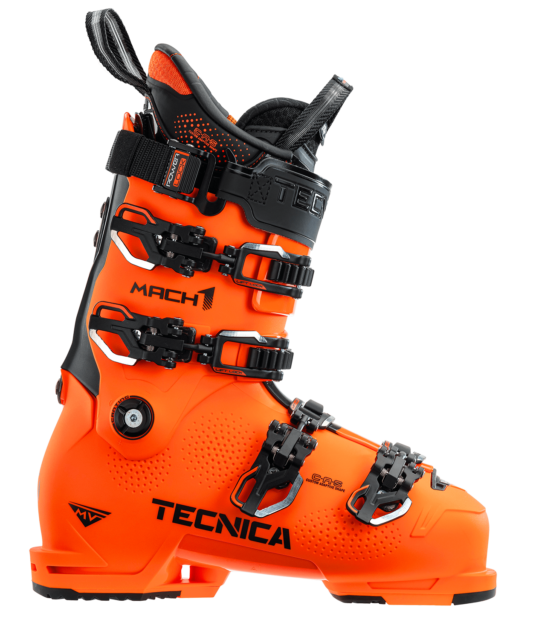
Boot: 2022-2023 Tecnica Mach1 LV 130 TD
Days Skied: ~40
Stated Flex: 130
Available Sizes: 24.5–30.5
Stated Last (size 26.5): 98 mm
Stated Forward Lean: 12°
Size Tested: 26.5
Stated Boot Sole Length: 305 mm
Blister’s Measured Weight (size 26.5):
- Shells, no Liners: 1518 g (Left) & 1518 g (Right)
- Liners, no Footbeds: 447 g & 450 g
- Shells + Liners = 1965 g & 1968 g
- Stock Insoles: 23.5 & 23.5 g
- Removable Spoilers: 17.5 & 17.5 g
Buckles: 4 micro-adjustable
Powerstrap: 45mm-wide cam-style
Shell Material:
- Cuff: polyurethane
- Shoe / Clog: polyurethane
Soles: GripWalk (alpine available)
Binding Compatibility: GripWalk-branded bindings, MNC-branded bindings
[Note: Our review was conducted on the 20/21 Mach1 MV 130 and 21/22 Mach1 LV 130, which return unchanged for 22/23, apart from a switch to having GripWalk soles out of the box.]
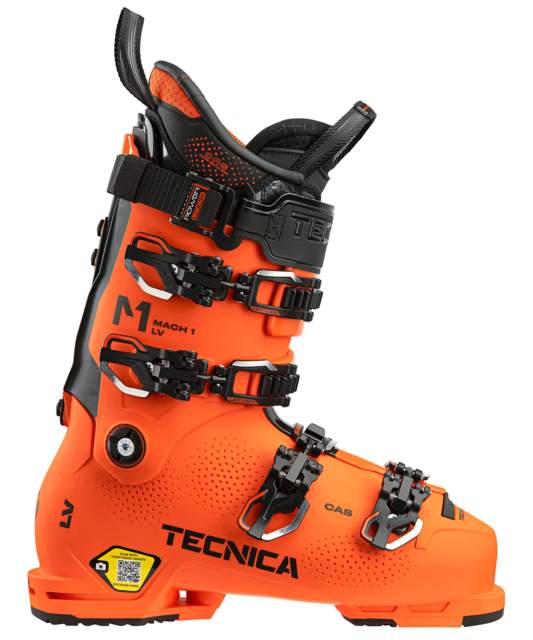
Intro
Tecnica’s Mach1 series of all-mountain boots have been around for many years now, but they’ve been implementing various updates to them over the past few years. As we outlined in our Tecnica Ski Boot Brand Lineup Deep Dive, the Mach1 series spans from the 98mm-last Mach1 LV to the 100mm-last Mach1 MV and 102mm-last Mach1 HV, all of which share a very similar overall construction.
The most recent update across the line has been the addition of Tecnica’s “T-Drive” cuff-to-shell construction, which was first added to the Mach1 MV for 20/21, then the Mach1 LV for 21/22, then the Mach1 HV for 22/23.
We’ve been spending a lot of time — as in, 200+ days — in both the MV and LV versions of the latest Mach1 130, on everything from frontside carvers to fat pow skis. Here we’ll offer our long-term thoughts on both boots.
What Tecnica says about the Mach1 MV 130
“The Mach1 MV 130 TD is the benchmark for performance, fit and customization in a ski boot. Tecnica’s engineers consulted with a round-table of bootfitters who hold a combined 100-plus years of experience and then brought those ideas and solutions to our boot-makers in Italy. The result is a best in class medium volume fit that is specially engineered to ski anywhere and everywhere, regardless of conditions. T-Drive Technology, a cuff-to-shell interface, fundamentally improves the boot’s power transmission, provides a smooth, progressive flex and increases energy efficiency allowing you to ski longer with less fatigue. It also provides a consistent flex throughout changing temperatures. The anatomically shaped shell and liner provides a comfortable out-of-the-box fit. If needed, you can add personal customization with Tecnica’s C.A.S. system to solve any additional fit problems. Demanding skiers will appreciate the Asymmetrical Power Transmission shell, which significantly improves energy transfer. Mach1 has always stood for performance with great fit, and the 130 will take you anywhere in any conditions.”
Shell
The Mach1 boots feature a polyurethane cuff and shell, but with a few twists.
First, they feature Tecnica’s “Quick Instep,” which is essentially a softer type of plastic over the instep area (the black part) for easier entry / exit of the boots. And having stepped in and out of these boots a few hundred times, I will say they are very easy to get in and out of.
Second, they feature Tecnica’s “T-Drive Technology,” which they describe like this: “a cuff-to-shell interface, fundamentally improves the boot’s power transmission, provides a smooth, progressive flex, and increases energy efficiency allowing you to ski longer with less fatigue. It also provides a consistent flex throughout changing temperatures.”
Essentially, this is a piece of carbon that connects the upper cuff and lower shell, attached via two bolts up top and one on the bottom. This debuted on the 20/21 Mach1 MV series, then was integrated into the Mach LV for 21/22 and Mach HV for 22/23.
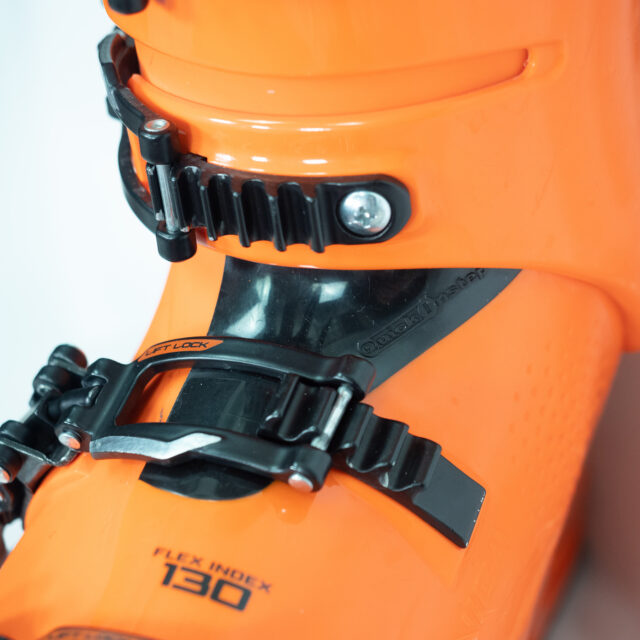
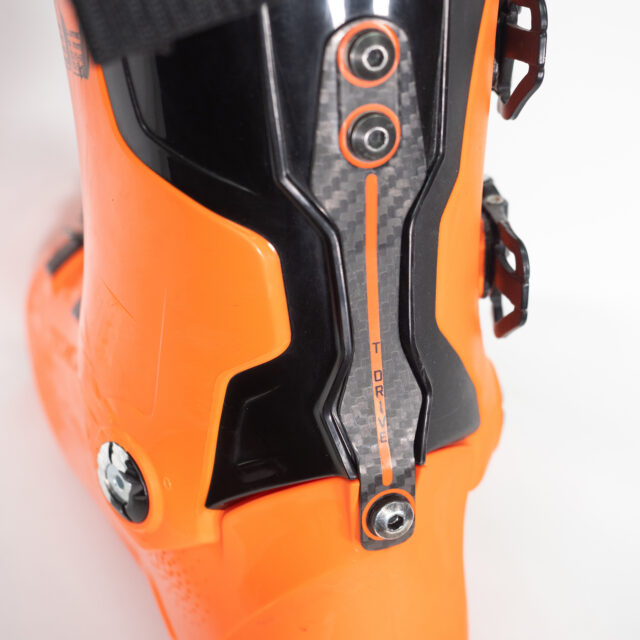
The Mach1 boots also feature Tecnica’s “Asymmetric Power Transmission” construction, which uses a thicker shell wall on the inside and a thinner shell wall on the outside, with the goal of increasing lateral power transmission, edge grip, sensitivity, and “more controlled edge-to-edge transition.”
Lastly, the Mach1 boots also feature dimples in the shell at common fit-problem areas like the ankle and midfoot, with the goal of making stretching and punching easier for bootfitters.
Liner
The 130-flex Mach1 boots come with Tecnica’s “high performance” C.A.S. (“custom adaptive shape”) liner, which is heat moldable and features an adjustable-height tongue and zones of dense material around the ankle pocket that a bootfitter can grind or punch.
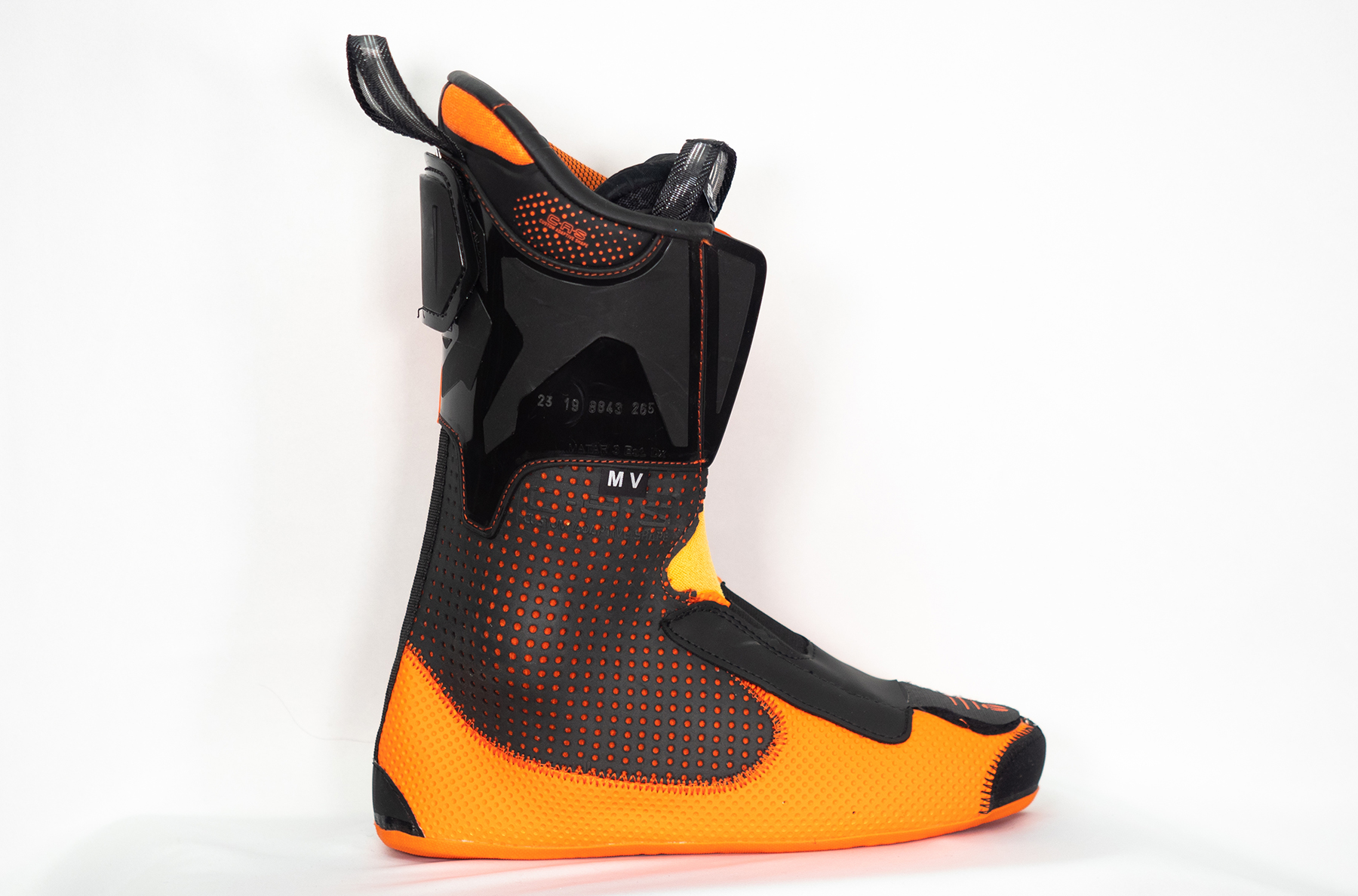
I’d say this is a pretty beefy, dense, and well-designed stock liner. Overall, it’s one of the better stock liners I’ve used, and we’ll talk more about that below.
Forward Lean & Cuff Alignment
The Mach1 boots don’t have built-in forward lean adjustment, but they do come with a removable spoiler and built-in cuff alignment adjusters at the cuff pivot.
Buckles
The Mach1 boots feature four micro-adjustable metal buckles that are easy to use and have held up great after hundreds of days.
Power Strap
The 130-flex Mach1 models come with a 45mm-wide power strap with a cam-style tightening mechanism and a metal hook for completely undoing the strap.
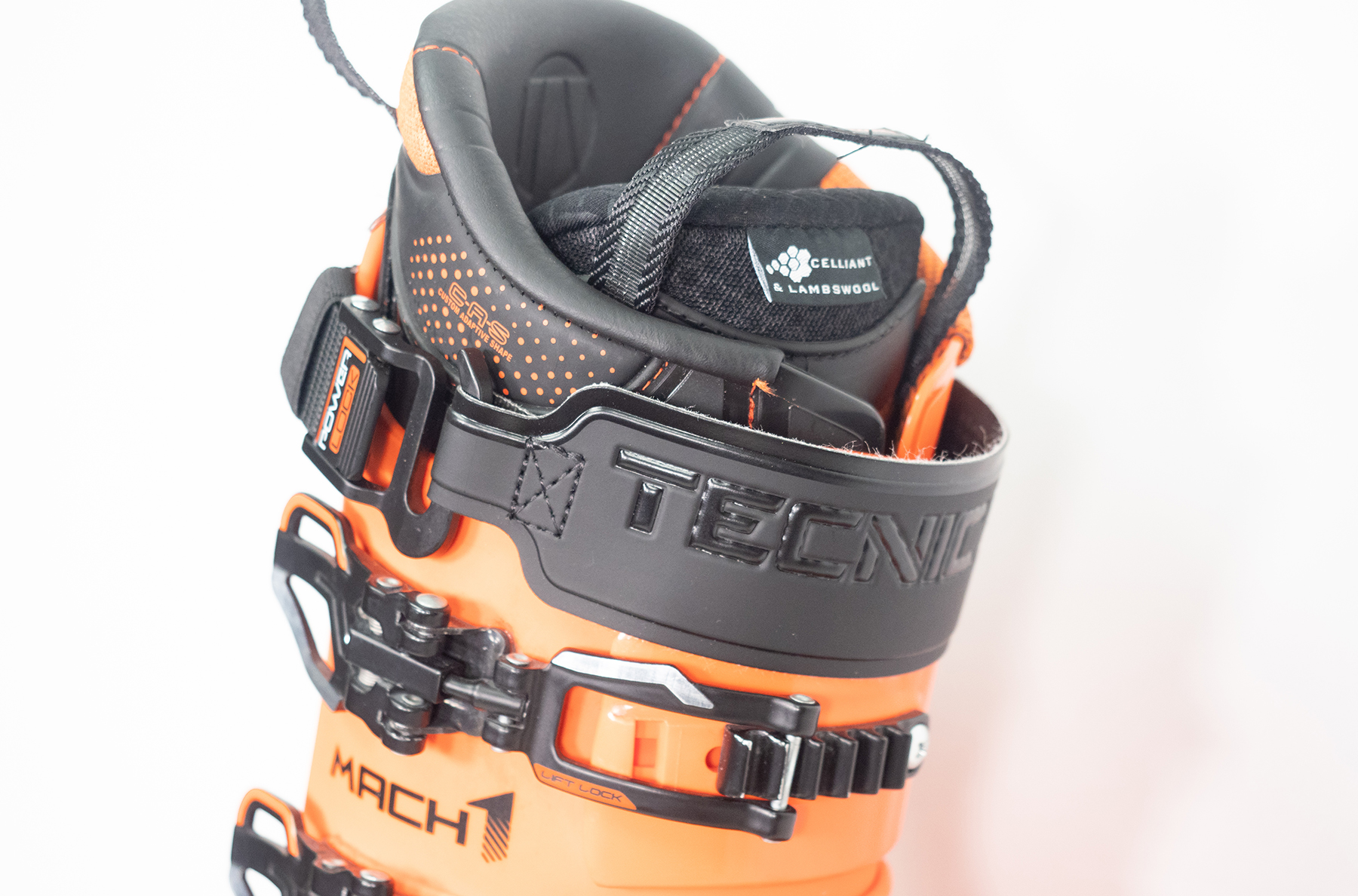
Soles
Prior to 22/23, the Mach1 boots came stock with replaceable alpine-norm (ISO 5355) soles and had GripWalk soles available aftermarket.
Starting in 22/23, the Mach1 boots now come stock with GripWalk soles, but alpine soles are still available.
Weight
The Mach1 boots are neither super light nor super heavy compared to the current alpine-boot market. At around 2000 grams per boot for a size 26.5, they are notably heavier than the newer lightweight class (K2 Recon, Atomic Hawx Ultra, Salomon S/Pro), but still a good bit lighter than more piste-oriented options like the Head Raptor and Atomic Redster CS.
Weight Comparisons
For reference, here are a few of our measured weights (shells + liners) for several alpine boots:
Head Nexo LYT 130 (26.5): 1082 & 1089 + 427 & 436 = 1509 & 1525 g
K2 Recon 130 LV (26.5): 1276 & 1277 + 369 & 374 = 1645 & 1651 g
Salomon S/Max 130 Carbon (26.5): 1291 & 1292 + 445 & 446 = 1736 & 1738 g
Atomic Hawx Ultra 130 S GW (26.5): 1375 & 1376 + 410 & 413 = 1785 & 1789 g
Salomon S/Pro Alpha (26.5): 1408 & 1417 + 399 & 400 = 1807 & 1817 g
Salomon S/Max 130 (26.5): 1389 & 1407 + 433 & 429 = 1822 & 1836 g
Nordica Promachine 130 (26.5): 1428 & 1428 + 444 & 445 = 1890 & 1891 g
Tecnica Mach1 LV 130 TD (26.5): 1518 & 1518 + 447 & 450 = 1965 & 1968
Head Formula 130 (26.5): 1557 & 1558 + 468 & 470 = 2027 g & 2029 g
Tecnica Mach1 MV 130 TD (26.5): 1541 & 1539 + 491 & 501 = 2032 g & 2040 g
Head Formula RS 130 (26.5): 1587 & 1588 + 466 & 466 = 2052 g & 2053 g
Rossignol Hi-Speed Elite 130 (26.5): 1610 & 1607 + 442 & 446 = 2052 & 2053 g
Lange RX 130 LV (26.5): 1676 & 1678 + 430 & 430 = 2106 & 2108 g
Lange RS 130 LV (26.5): 1634 & 1634 + 481 & 489 = 2115 & 2123 g
Atomic Redster CS 130 (26.5): 1773 & 1778 + 435 & 434 = 2208 & 2212 g
Head Raptor 140 RS (26.5): 1892 & 1899 + 547 & 548 = 2439 & 2447 g
Fit
As always, our “Fit” sections will never replace the usefulness of the advice of an experienced bootfitter, nor are they designed to do so. The fit of any boot is the deciding factor and everyone’s feet are different, so we highly, highly recommend visiting a bootfitter before settling on a boot. With that said, here are some of our thoughts on the fits of the Mach1 MV and Mach1 LV boots.
Fit: Mach1 MV
Luke Koppa: For reference, I have a fairly wide midfoot, low instep, low-volume ankle, and skinny calves. Before the Mach1 MV, the boot that fit me best was the Nordica Strider / Speedmachine, though I had to punch out the midfoot a bit and raise my heel slightly to get it to work for me.
Frankly, the main reason I’ve spent so many days in the Mach1 MV 130 is that it’s by far the best out-of-the-box fit I’ve ever had in a boot. I still sometimes get pain at the widest point in my midfoot (particularly when it’s warm outside or I’m bashing firm moguls all day), and I have more room around my ankle and instep than I’d prefer, but still, this boot fit me really well from the start, all things considered.
Compared to other “MV” boots with stated lasts around 100 mm, I think the Mach1 MV has a slightly lower-volume ankle, lower instep, and (maybe) wider midfoot than average, which is why I think it works so well for my feet.
Fit: Mach1 LV
Dylan Wood: I have a pretty low-volume foot overall, with a low instep and skinny calves. My reference boot is the Atomic Hawx Ultra 130 S GW, and I have been able to ski almost all “low volume” boots right out of the box without requiring any work (up until I got some calcification directly under my outside ankle bones on both my feet this season, but that is another story for another time, as it had nothing to do with the Mach1).
So, like most “LV” boots, I got along well with the Mach1 LV 130 out of the box. I would say this is a pretty true low-volume boot, and is definitely snugger overall than the Lange RX 130 LV, and more comparable to the Atomic Hawx Ultra 130. The Mach1 LV’s toe box is on the shorter side lengthwise, though it is fairly roomy width-wise. Compared to other “LV,” ~98 mm last boots, I’d say the Mach1 LV has a slightly more snug heel pocket, slightly lower instep, a pretty average midfoot, and an average cuff.
FULL REVIEW
Luke Koppa: For reference, I’ve now put 200+ days in two pairs of the Mach1 MV 130 TD (spoiler alert: my first pair broke after about 120 days; I’ll touch on that below). Those days were spread out over two full seasons, so I’ve been able to ski this boot in basically every condition and terrain we get here in Mt. Crested Butte. And overall, I’m a huge fan. The Mach1 MV and Mach1 LV share a very similar construction and some on-snow similarities, though Dylan and my experiences in the two boots have been slightly different, so we’ll cover both our experiences here.
Flex Pattern
Luke (5’8”, 155 lbs / 173 cm, 70 kg): The Mach1 MV 130’s flex pattern has pretty much everything I personally want from a good alpine boot. It’s fairly easy to initiate that flex and bend the boot at the beginning, but it gets progressively stiffer the harder I push into it and the more I flex the boot.
I haven’t skied as many other boots as Dylan or some of our other reviewers, due to my foot being difficult to work with and me being lazy about doing boot work, but I can make a few comparisons. Compared to the Head Formula 130, the Mach1 MV 130 feels a bit stiffer at the beginning of its flex pattern and maybe a touch softer very deep into its flex pattern, but I personally prefer the Mach1 MV 130’s flex pattern cause it ramps up a bit quicker and more smoothly. There’s also a good chance some of my preference comes down to the fact that the Mach1 MV 130 fits me much better and I’m more used to its flex pattern.
Compared to the Nordica Speedmachine3 130, the Mach1 MV 130 is notably stiffer overall — the Speedmachine3 130 feels more like a “120” to me, whereas the Mach1 MV 130 very much feels like a “true 130 flex” boot. Compared to my old Nordica Strider 120, the Mach1 MV 130 is unsurprisingly notably stiffer overall, particularly deeper into its flex pattern, and significantly stiffer in terms of rearward support.
On that note, the rearward support of the Mach1 MV 130 feels very good to me. I’ve never felt like I couldn’t get out of the backseat because of the boot. I’m not someone who tends to notice a lack of lateral support in riveted-cuff alpine boots, and that held true for the Mach1 MV 130 — no complaints in that department.
In terms of temperature stability, I’d say the Mach1 MV 130 is pretty good. It feels a little bit softer when temperatures are well above freezing and a bit stiffer when temps are close to 0°F (-18°C), particularly at the beginning of its flex pattern. But compared to other boots I’ve used, I’d say the Mach1 MV 130 is average or above average when it comes to how consistent its flex pattern feels across a wide range of temperatures.
All in all, the Mach1 MV 130’s flex pattern just feels really nice, supportive, and predictable to me. Over two full seasons in it, I’ve never had an instance where I all of a sudden “blew through” the flex pattern of the boot, but it’s also always pretty easy to ease myself into its flex pattern.
Dylan Wood (5’10”, 155 lbs / 178 cm, 70 kg): My experience with the Mach1 LV 130 is mostly similar to Luke’s experience with the Mach1 MV 130. However, the Mach1 LV 130 is notably stiffer off the top of its flex pattern than the majority of 130-flex LV boots I’ve used. Also, I would say that the Mach1 LV 130 has a more linear flex pattern than most other boots in its class; it starts off quite stiff and if it were as progressive as say, a Lange RX 130 LV, it would be pretty unbendable pretty quickly in the flex pattern. While I do think there is some progression in the flex curve of the Mach1 LV 130, it has an effectively flatter and more linear flex pattern curve than most similar boots. In fact, I don’t think I’ve skied a boot that is as stiff off the top as the Mach1 LV 130; even the Head Raptor WCR 140 was easier to flex off the top.
[Luke: That’s interesting. I can’t say whether the Mach1 MV is more progressive than the Mach1 LV, but I will say that the Mach1 MV feels notably more progressive than the 3-piece Dalbello Lupo Pro HD, which feels notably stiffer off the top but a bit softer really deep into its flex pattern.]
Dylan: I am in full agreement, however, about the rearward support of the Mach1 LV 130. It is one of the stiffest boots in the rearward direction that I’ve been in, and offers loads of support.
I would also say that the Mach1 LV 130 feels pretty temperature-stable. I can definitely notice it softening up a little on above-freezing springtime days, and I can also notice it stiffening up on those extra cold days, say ≤ 10ºF (-12º C). I’d call its temperature stability pretty average, though I am sure it doesn’t help the Mach1’s case that I spend most of my time in the Atomic Hawx Ultra 130, a boot that I’ve found to be exceptionally temperature-stable.
Overall, I’d say the Mach1 LV 130 is on the slightly stiffer side of the “130-flex” spectrum for all-mountain boots, and I never found myself blowing through its flex either.
Suspension / Damping / Ride Quality
Luke: At around 2000 grams per boot in a size 26.5, the Mach1 MV 130 isn’t super heavy, but it is heavier than the newer class of lightweight alpine boots. And the upside to that is that the Mach1 MV 130 offers notably better suspension / vibration damping than lighter boots like the K2 Recon, and even the not-that-much-lighter Nordica Speedmachine3. I’ve spent a lot of days skiing the Mach1 MV 130 in very firm conditions and have zero complaints about its ride quality. Yeah, it feels kinda clunky when walking to the lifts, but in my experience, just about every ski boot does, no matter its weight. And once I’m skiing (or even bootpacking in the resort when our T-bars were closed this season), I never think about the weight of these boots.
Dylan: Agreed. The Mach1 LV 130 has nice suspension without being super heavy and feeling as if it is weighing down my feet. It definitely feels more damp than the Atomic Hawx Ultra, K2 Recon, and Salomon S/Pro Alpha, to name a few boots that fall under this “newer class of lightweight alpine boots” that Luke is referring to. While we don’t typically do much bootpacking here at Mount Crested Butte, we do have a notable amount of terrain that requires side-stepping to, and I would much prefer to have the Mach1 on my feet for that over a heavier, notably more damp boot like the Head Raptor WCR 140 or Atomic Redster CS 130.
Adjustments
Luke: Over the course of the last two seasons, I’ve made a few adjustments to my two pairs of the Mach1 MV 130.
First, I added my custom insoles, which I do for every boot I review, and think just about everyone else should, too. You can listen to episode 184 of our GEAR:30 podcast to hear some rationale behind this from reviewer and bootfitter, Kara Williard.
Next, I swapped out the (pretty good) stock power strap for an “Expert/Racer” Booster strap, then an Atomic Professional Dual Strap. The Mach1 MV 130’s cam-style stock strap is wide and easy to cinch down for a stock, static strap, but after dealing with nasty shin bang for years, I really don’t like skiing an alpine ski boot without an elastic power strap. Fortunately, the Mach1 MV 130’s stock power strap is attached to the cuff via actual screws (not rivets), so the swap was super easy.
Lastly, this year I was fortunate to be able to try the Mach1 MV 130 with Atomic’s custom-injection Mimic Professional liner. As I mentioned above, I really like the Mach1 MV 130’s stock liner and probably skied about 120 days in it. I ended up adding one volume-reducer / shim to the stock liner after about 60 days, then another when it got hot later in the season, since it started to feel a bit loose after it packed out a bit. This is something I end up doing with most stock liners after a similar period of time.
With the Mimic Professional liner, I was able to get a notably snugger fit through the ankle and instep area, relative to the stock liner. The Mimic Professional’s injected material in those areas does feel a bit firmer / less flexible than the Mach1’s stock liner, but I haven’t been bothered by it.
All that said, these were all personal-preference adjustments, and while I always skied it with my custom insoles, I was still quite happy with the performance of the Mach1 MV 130 before I swapped its power strap and liner.
Dylan: I spent a stupid amount of time in stock insoles before February of this year (trust me, Kara thinks I’m an idiot), including in the Mach1 LV 130. Learn from my mistakes (remember the calcification on my feet I was talking about earlier?) and get custom insoles, regardless of the boot you’re in and how well you think it fits you.
After Luke swapped his Booster Straps out for Atomic’s Professional Dual Straps, I stole his Booster Straps and put them on the Mach1 LV 130. While I do think an elastic Booster strap makes the Mach1 LV 130 slightly softer off the top and ever-so-slightly more progressive, this wasn’t the main reason I swapped out the power strap. Even with the cuff buckles about 3 ladder slots out from fully tightened, I could not fully tighten the power strap down to the boot and the cam-style buckle maxed out on the male end of the strap. This might be worth noting for those who have skinny calves.
Other than swapping out the power strap, I did not modify the Mach1 LV 130 at all. I did use the spoiler on the back of the liner to take up volume in the calf through the entire duration of my time in the boot, though.
Long-Term Durability & Ease of Use
Luke: I’ve spent a lot of time with the Mach1 MV 130, so I figured this would be a good chance to add some notes about how it’s held up and how it is to use on a daily basis.
As I mentioned above, the Mach1 MV 130 is very easy to step in and out of, for a riveted-cuff 130-flex boot. All I have to do is lift up on the liner’s tongue and slide my foot in, then pull back on the cuff to get out.
The stock alpine soles that came on my pair (before the change to GripWalk for 22/23) held up quite well, with them not being that rounded off, even after 120 days. I also like that they’re replaceable, and even the alpine soles feature a bit of rubber for better grip on pavement than full-plastic soles.
One thing to keep an eye on if you get any Mach1 boots with Tecnica’s T-Drive cuff is the lower bolts that attach the T-Drive spine to the lower shell. Over the course of my time in these boots, I’ve had three of those bolts loosen up and fall out. They come with Loctite on the bolts but I’ve now gotten in the habit of just giving them a quick hand-tightness check before going out for the day.
Interestingly, I actually didn’t notice much of a difference in performance when the boots were missing that lower bolt. I spent several weeks skiing with one boot missing that bolt and the other having it, in an attempt to see just how much that T-Drive piece was doing / not doing, and the differences were super subtle to me. There were a few instances where I felt like I was more easily flexing the bolt-less boot, particularly really deep into the flex, but that was pretty much it. I’d be curious to hear if others noticed more of a difference than I did.
Now, the elephant in the room: I broke the shell on one of my Mach1 MV 130s. One of the cuffs from the first pair cracked right where it meets the pivot, after about 120 days of skiing in it. I don’t remember any specific impact or event that could have caused this, and I actually didn’t notice it until my friend pointed it out while we were bootpacking. Unfortunately, I’m definitely not the only one who’s had this issue — I’ve talked to three people at Mt. Crested Butte who had their Mach1 MV or LV boots crack in the same spot. However, every single one of them got their pair warrantied by Tecnica and had a new pair in hand very promptly, so I’m glad that Tecnica is standing behind their products. I have yet to crack my second pair after roughly 90 days in it, but I’ll be sure to update this section if I run into any issues in the future.
Update 3.27.23: After about 140 days in my second pair of the Mach1 MV 130, one of the shells cracked, this time over the instep area, around where the softer black material meets the stiffer orange material. This is where a friend of mine had her pair of Tecnica Cochise Pro W’s crack, though mine happened after a much longer period of time. I’m working on getting them warrantied and will report back.
Other than that, the shell of the Mach1 MV 130 has held up well to getting bashed into a whole lot of rocks, skis, parking lot curbs, etc. It’s got plenty of superficial scrapes, and the interior cuff-alignment plate on the pivot is pretty scoured from me hitting my boots and skis together all the time, but those are all just aesthetic damages. The stock liners also seem to keep from packing out a bit better than most stock liners I’ve used; I was still happy with them after over 100 days (with the addition of a shim or two). All the buckles and straps are also still functioning flawlessly.

Dylan: In the ~40 days I used the Mach1 LV 130, I had no issues with the durability of the shells. The liners did pack out a little, and I ended up adding a 2 mm shim between the liners and footbeds of each boot, though I would say this is pretty standard protocol for all boots I’ve spent time in. Other than that, every part of this boot remained intact and functioning.
Who’s It For?
Luke: Regarding the Mach1 MV 130, I think it’s a very good all-round alpine boot for folks who need a medium-volume boot, want a progressive and legit “130 flex,” and who prioritize suspension / damping over minimum weight. Of course, whether it actually works for you will come down to fit. But in terms of performance, it compares very favorably to other medium-volume alpine boots when it comes to flex pattern, suspension, and features.
Dylan: The Mach1 LV 130 is a good low-volume all-mountain boot for people who are seeking out a true “low-volume” fit and want a strong, supportive, legit “130-flex” boot. It is an especially good option for those who want a flex pattern that is pretty stiff off the top and a bit more linear than most 4-buckle all-mountain boots. It is also a particularly good option for those who feel caught between the lighter all-mountain boots of today and heavier, more classic “recreational race” boots. But, as Luke mentioned, get the opinion of a boot fitter and see if the Mach1 LV offers the right fit for your feet.
Bottom Line
The Tecnica Mach1 MV and LV 130 are strong alpine boots with pretty progressive flex patterns (maybe more so with the MV version than the LV), better suspension than most lighter alternatives, and a variety of features that make using them and customizing them easier than some alternatives.




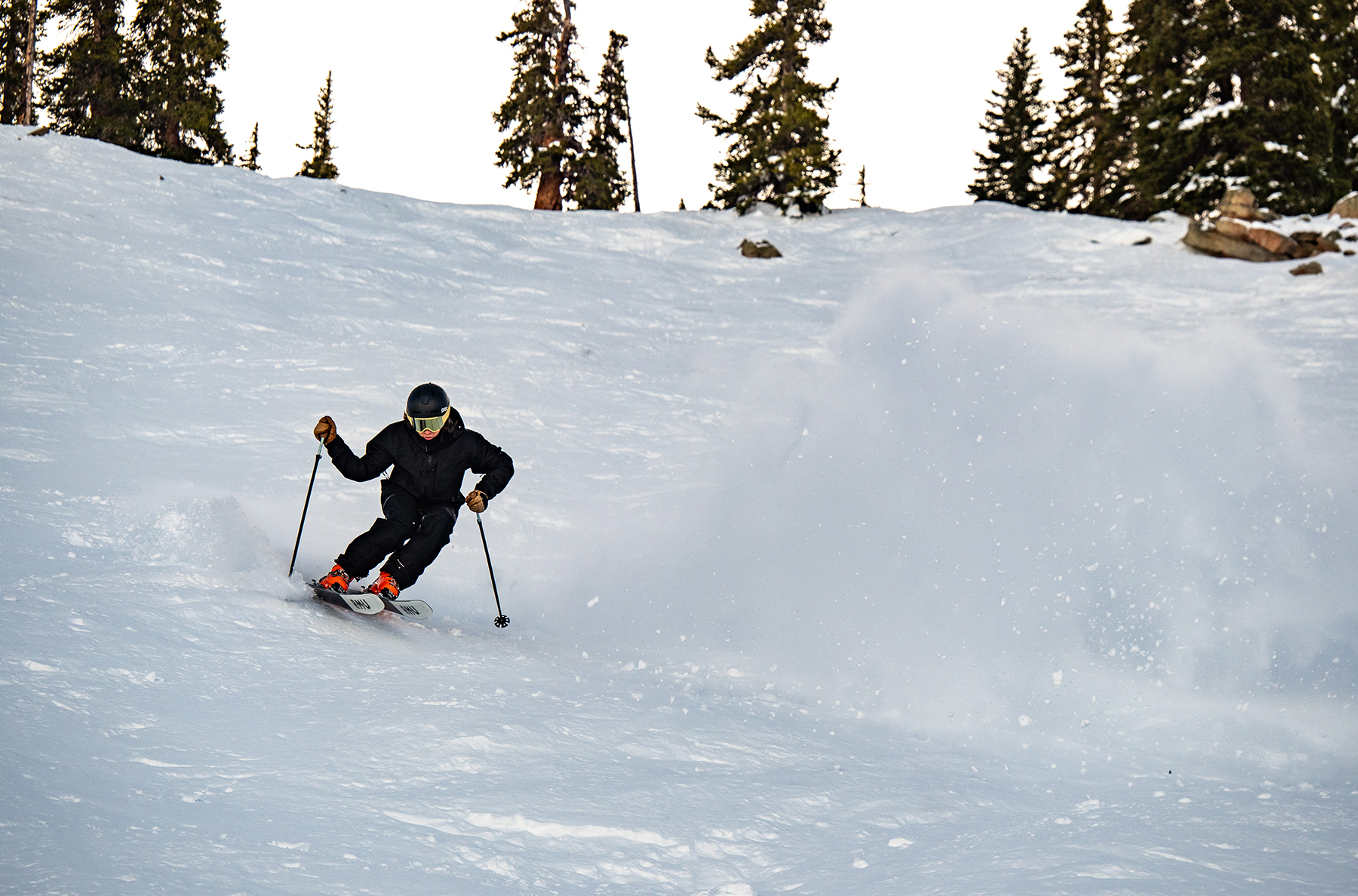
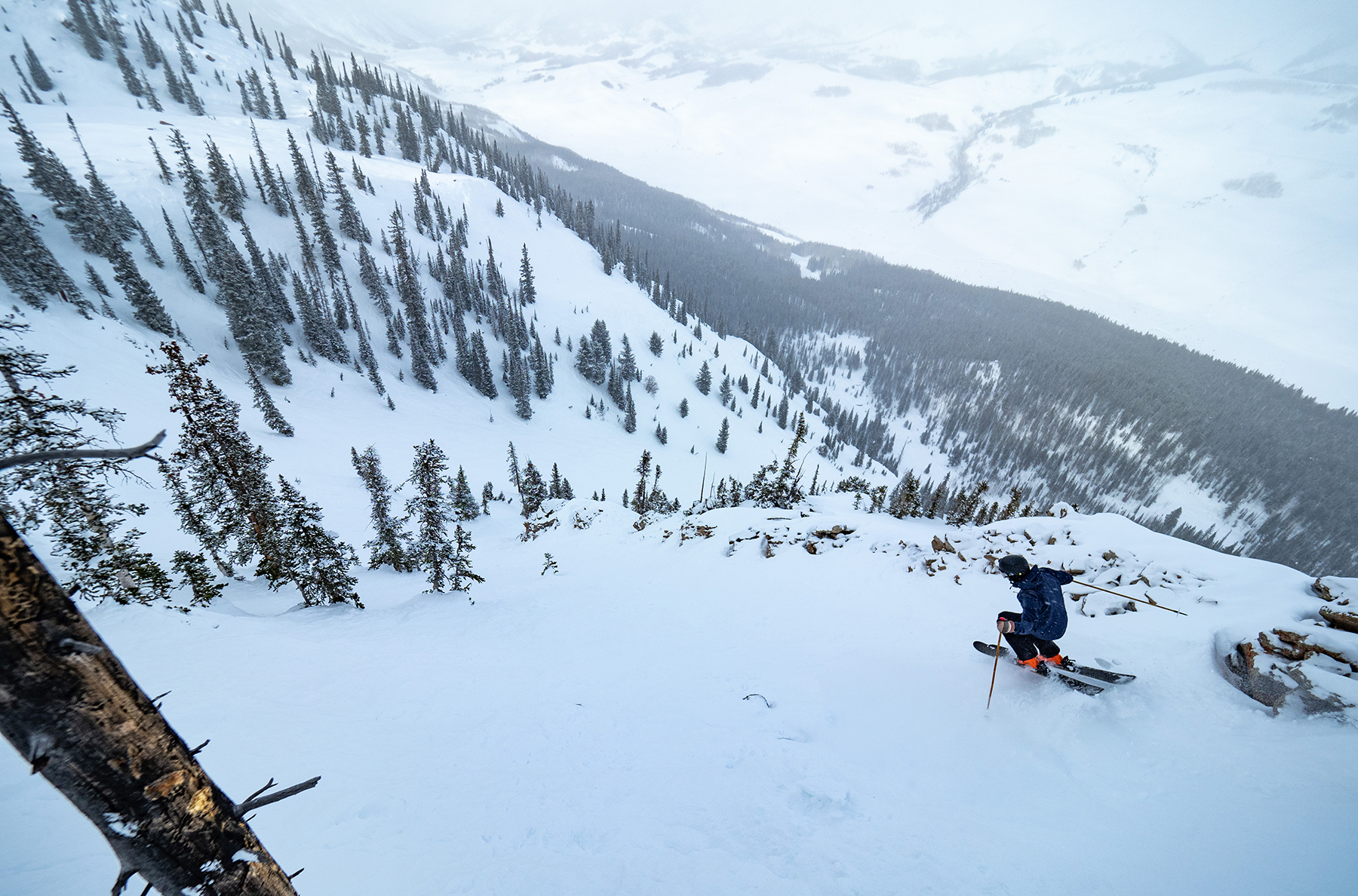
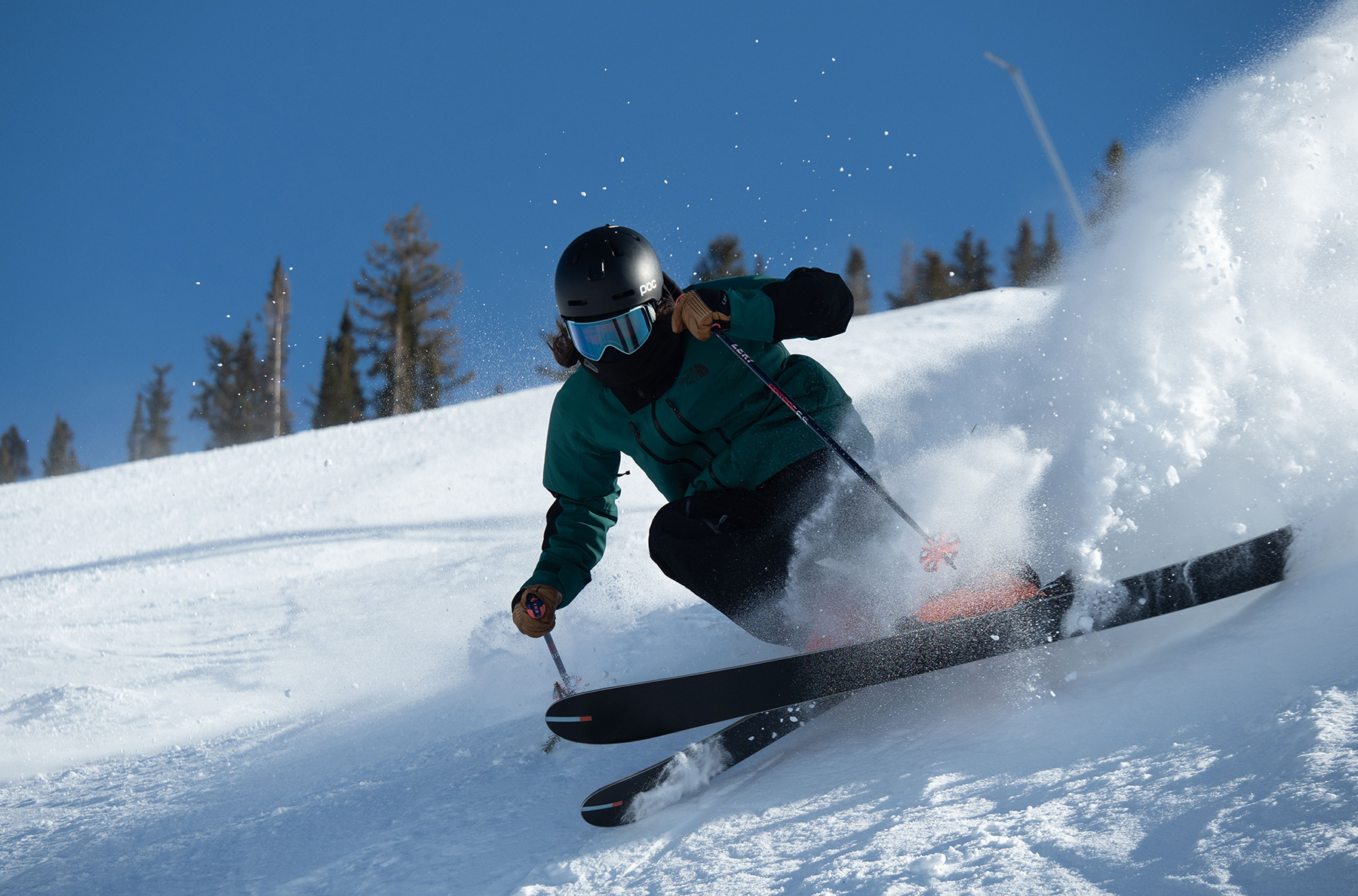
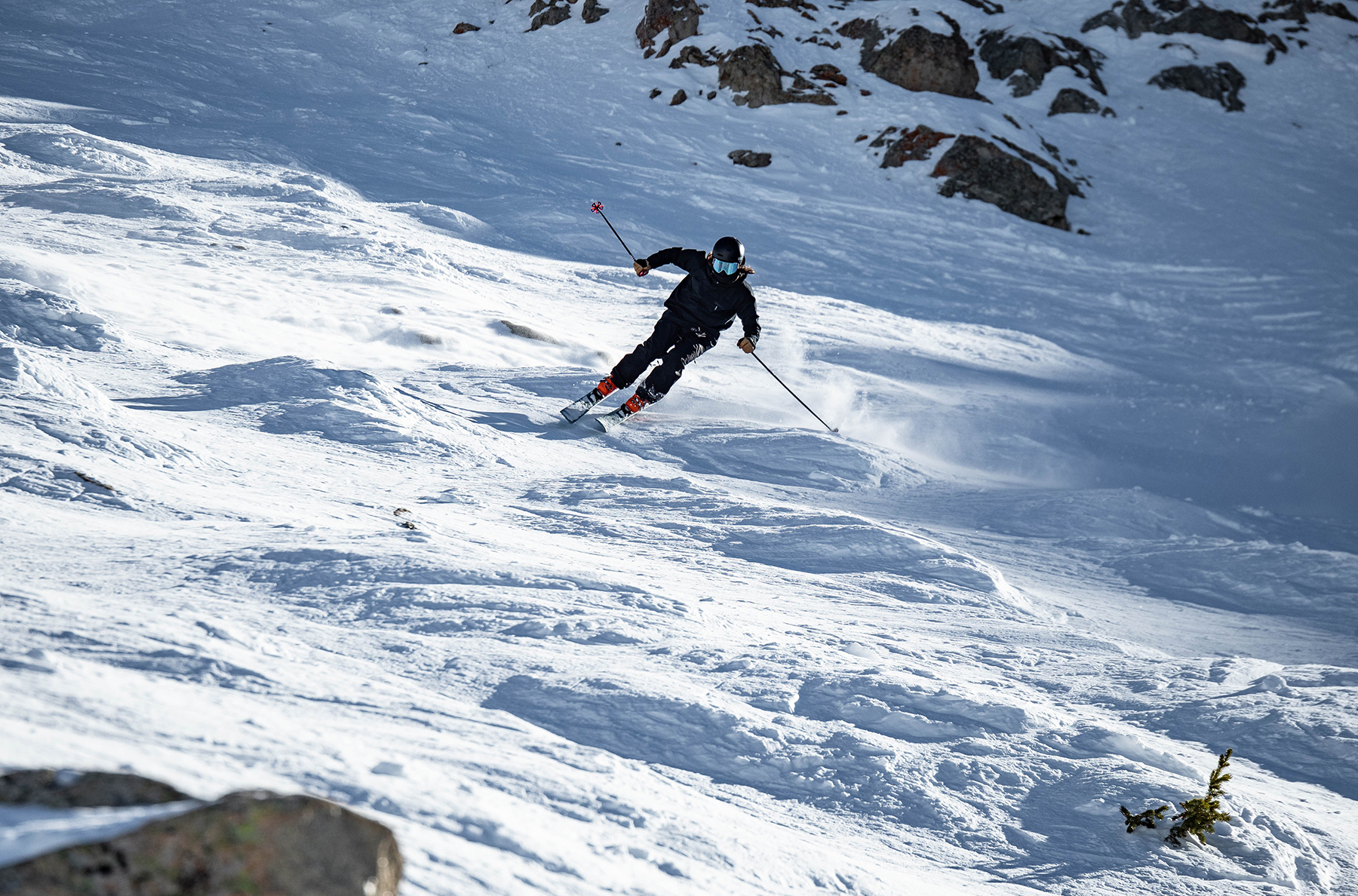
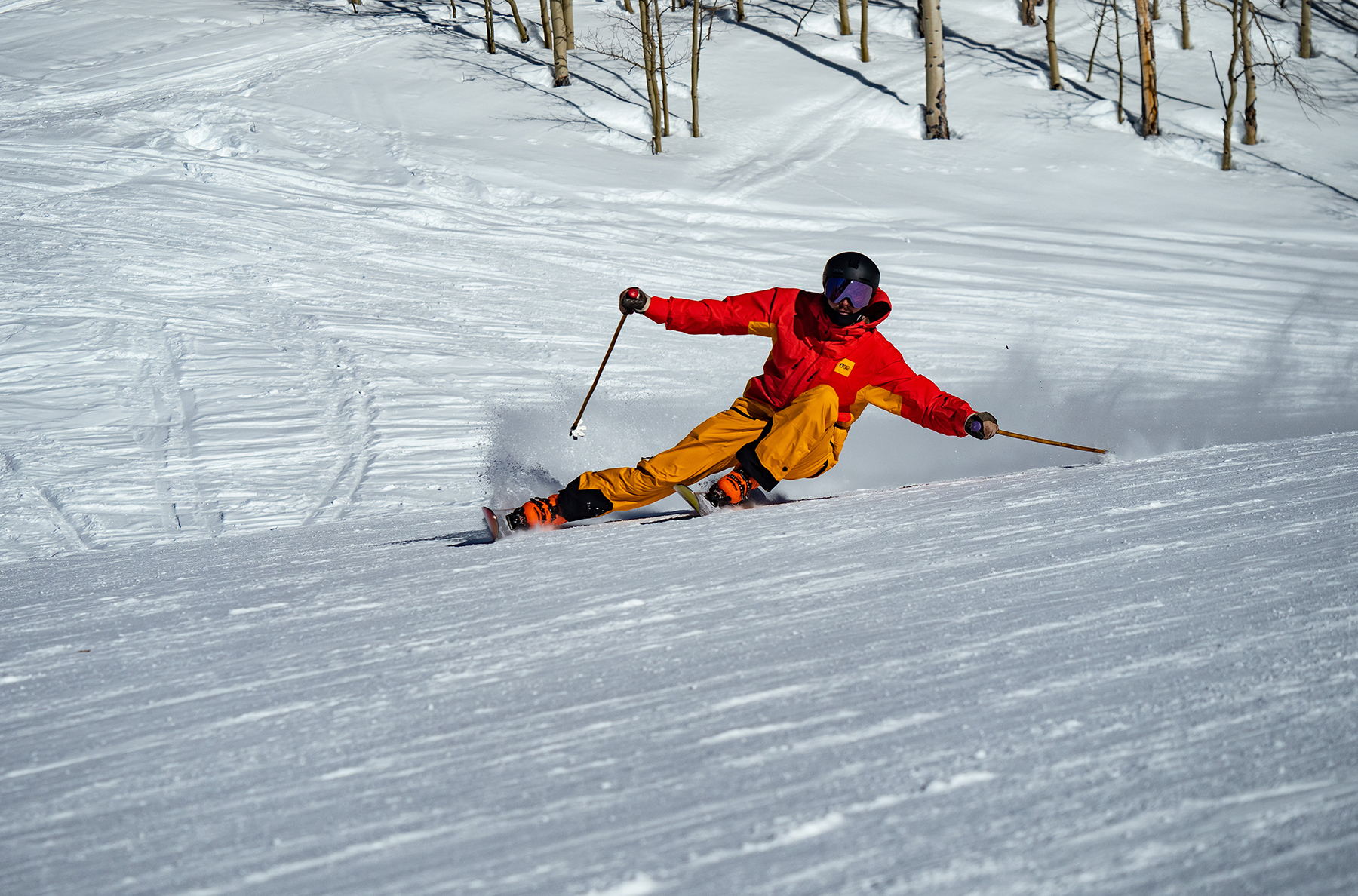

Picked up the 130lv earlier this season, and have about two dozen days on them. Love them for so many reasons. They fit almost perfect out of the box, but punched super easily for that last bit of fit. They feel great carving super low, hitting jumps, surfing through spring slush, whatever
I agree with Dylan about the strap, I’ve almost got it bottomed out to the rivet
Hi
Can you comment on fit and performance vs Cochise 130?
+1, would love to know how much of a difference there is.
How would you compare Tecnica Mach1 130 LV with Salomon X-max 130? Thanks
A word on the last–
I’ve skied the MV version for the last 2 seasons, about 65 days. I’m a bigger dude…started last year’s season at 240lbs, now to down to 205-210lbs. Race background…I’m nothing special, but only to indicate that stylistically I preference high-speed carving with a lot of force into the boot than new school stylish frippery :) I also sweat a fair bit, even in my newly svelter body shape.
I’ve previously skied the LV lasted Salomon Xmax130 which. I agree this MV fit was perfectly snug but not hellishly painful out of the box (for reference I use a 28 shell for my size 14 foot which I’ve been told is not a particularly low volume foot).
I broke that liner down in about 20 days and started adding space-occupying foam shims to the boot. It was a little disappointing how quickly the fit started to feel sloppy. I would have gotten something new after last year and called this boot a bust, but the Atomics I ordered never showed up as skis.com went bust. So I stayed with this boot for this year. It ended up skiing fine with the shims duct taped to the liner and didn’t break down nearly as much as I feared for the rest of this season.
Buyer beware that if you’re the type that tends to destroy ski boot liners (heavier, a little sweaty, skis like a highland gorilla trying to slice the hill in half), you may want the lower volume shell despite the egregiously tight initial fit.
I came to add about the same comments as AR. 250lb, 6’2′, strong ex racer, with a size 14 in 29.5 MV. I am the highland gorilla. I have a similar foot to what Luke describes above. Flat arch (wide midfoot), lowish instep, average forefoot, skinny calves and ankles. As far as fit, I’d describe it exactly as Luke did above.
Like AR, the boots were perfectly snug out of the box, just slightly painful, but skiable. I did no boot work and did not mold. The liners packed out after 15 days and started shimming. Shims did ok with the volume in the lower, but even after moving the ladders on the cuff, I could not get them snug on my ankle and calf. It feels like I will break a buckle before I can ever get these snug enough.
I ordered the LV in 29.5 to try and was able to wear them comfortably around the house right out of the box for an hour. Really the only problem was width midfoot, which got pretty painful. I’m thinking with a new thinner custom insole to support the arch I could make these work. My current insole is to thick. Cuff was much more secure on my leg than the MV, and wrapped snug around my instep. With the MV the instep buckle just never wrapped properly.
So yeah, I’ll echo AR here. These liners pack out quickly if you are a big agressive guy.
Luke: Have you tried the LV? Just curious as out feet are simliar and id be most concerned with the midfoot. Either I pad out the cuffs in the MV for next season or ditch these things for the LV.
I’ve tried on about every 130 boot out there and have found good fit in the Promachine 30.5, great fit in Hawx Prime 29.5 (to much deformation in lowers), RX 130 29.5 fit is perfect, but the cuffs are too damn short. I prefer traditional build and alpine soles, which is why I chose the Mach 1.
My experience with footbeds is that they mostly depend on your particular foot. While completely agreeing with the idea a good footbed is mandatory after A/B testing earlier this year with one BootDoc footbed in and no footbed at all in the other boot I found zero difference in performance. For my foot, more a solid block than an assemblage of 26 some odd bones, the no footbed foot was more comfortable because it allowed space for the navicular/scaphoid. At the end of the day out of the boots both feet felt fine. For Dylan, increase your magnesium input, it keeps calcium from building up where it doesn’t belong.
Hi, how would you compare the tecnica mach1 lv 130 with Salomon S-Max 130? Thanks
is there warmth difference between the LV and MV? I noticed the LV doesnt have the Celliant liner
Is the stated 12 degrees of forward lean with the spoilers or without?
Just had my Mach1 MVs crack right at the pivot after only 20 days. In the process of getting warrantied. Hopefully my next pair will last longer, but this is clearly a design defect.